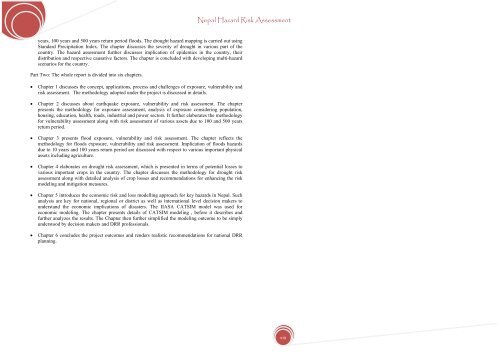Nepal Hazard Risk Assessment - Asia-Pacific Gateway for Disaster ...
Nepal Hazard Risk Assessment - Asia-Pacific Gateway for Disaster ...
Nepal Hazard Risk Assessment - Asia-Pacific Gateway for Disaster ...
You also want an ePaper? Increase the reach of your titles
YUMPU automatically turns print PDFs into web optimized ePapers that Google loves.
<strong>Nepal</strong> <strong>Hazard</strong> <strong>Risk</strong> <strong>Assessment</strong><br />
years, 100 years and 500 years return period floods. The drought hazard mapping is carried out using<br />
Standard Precipitation Index. The chapter discusses the severity of drought in various part of the<br />
country. The hazard assessment further discusses implication of epidemics in the country, their<br />
distribution and respective causative factors. The chapter is concluded with developing multi-hazard<br />
scenarios <strong>for</strong> the country.<br />
Part Two: The whole report is divided into six chapters.<br />
• Chapter 1 discusses the concept, applications, process and challenges of exposure, vulnerability and<br />
risk assessment. The methodology adopted under the project is discussed in details.<br />
• Chapter 2 discusses about earthquake exposure, vulnerability and risk assessment. The chapter<br />
presents the methodology <strong>for</strong> exposure assessment, analysis of exposure considering population,<br />
housing, education, health, roads, industrial and power sectors. It further elaborates the methodology<br />
<strong>for</strong> vulnerability assessment along with risk assessment of various assets due to 100 and 500 years<br />
return period.<br />
• Chapter 3 presents flood exposure, vulnerability and risk assessment. The chapter reflects the<br />
methodology <strong>for</strong> floods exposure, vulnerability and risk assessment. Implication of floods hazards<br />
due to 10 years and 100 years return period are discussed with respect to various important physical<br />
assets including agriculture.<br />
• Chapter 4 elaborates on drought risk assessment, which is presented in terms of potential losses to<br />
various important crops in the country. The chapter discusses the methodology <strong>for</strong> drought risk<br />
assessment along with detailed analysis of crop losses and recommendations <strong>for</strong> enhancing the risk<br />
modeling and mitigation measures.<br />
• Chapter 5 introduces the economic risk and loss modelling approach <strong>for</strong> key hazards in <strong>Nepal</strong>. Such<br />
analysis are key <strong>for</strong> national, regional or district as well as international level decision makers to<br />
understand the economic implications of disasters. The IIASA CATSIM model was used <strong>for</strong><br />
economic modeling. The chapter presents details of CATSIM modeling , be<strong>for</strong>e it describes and<br />
further analyzes the results. The Chapter then further simplified the modeling outcome to be simply<br />
understood by decision makers and DRR professionals.<br />
• Chapter 6 concludes the project outcomes and renders realistic recommendations <strong>for</strong> national DRR<br />
planning.<br />
xiii
















